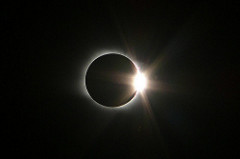The science event of the year
By Mary Bigelow
Posted on 2017-08-03
 Even if your location is not in the path of the total solar eclipse, viewing a partial one is an amazing event. If you’re looking for safety tips, a refresher on the science of eclipses, classroom activities on the topic, or professional development, NSTA has many resources to assist.
Even if your location is not in the path of the total solar eclipse, viewing a partial one is an amazing event. If you’re looking for safety tips, a refresher on the science of eclipses, classroom activities on the topic, or professional development, NSTA has many resources to assist.
Download the Observer’s Guide to Viewing the Eclipse
Check out ideas from others in the discussion forum or the Learning Center collection The Total Solar Eclipse of 2017
For young children, see The Early Years Blog Total Solar Eclipse on Monday, August 21, 2017!
Search for the topic Eclipses in SciLinks for grades 5-8 and 9-12
Start your Countdown to the Great American Eclipse with several articles in recent NSTA Journals:
- Total Eclipse shows how this event can be an opportunity for 3-dimensional learning.
- Modeling the Eclipse has ideas for studying eclipses through observations, planetarium and virtual modeling, as well as mathematical and physical modeling,
- The authors of Chasing Shadows suggest that the upcoming eclipse is also an opportunity for students to study exoplanets and astronomical transits.
- The August 2017 Total Solar Eclipse: The Perfect Opportunity to Highlight Three-Dimensional Science Learning has ideas for helping students understand phases of the moon, partial eclipses, and why they occur so infrequently.
- Preparing for the Eclipse and Eclipses and Eye Safety have suggestions for viewing and studying the upcoming eclipse safely.
- Eclipses Across the Curriculum has ideas for integrated lessons pertaining to the August 2017 event.
- Exploring Lunar and Solar Eclipses Via a 3-D Modeling Design Task has a lesson idea to help students understand the phenomenon and dispel misconceptions
If I were planning August professional development sessions, I would designate August 21 as Eclipse Day and focus on interdisciplinary teacher participation in this historic event. Of course, if your classes are in session then, you have an opportunity to view the eclipse with your students as a learning opportunity.
Photo: https://www.flickr.com/photos/sashapo/2722924752/
Disclaimer: The views expressed in this blog post are those of the author(s) and do not necessarily reflect the official position of the National Science Teaching Association (NSTA).


